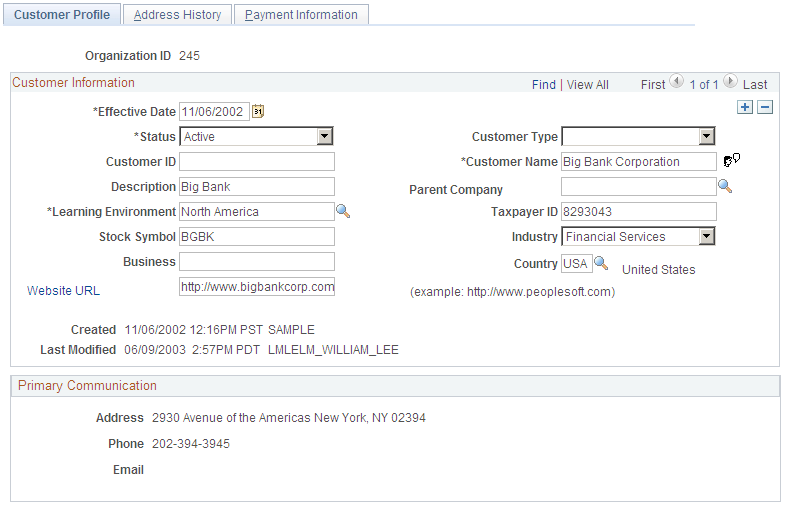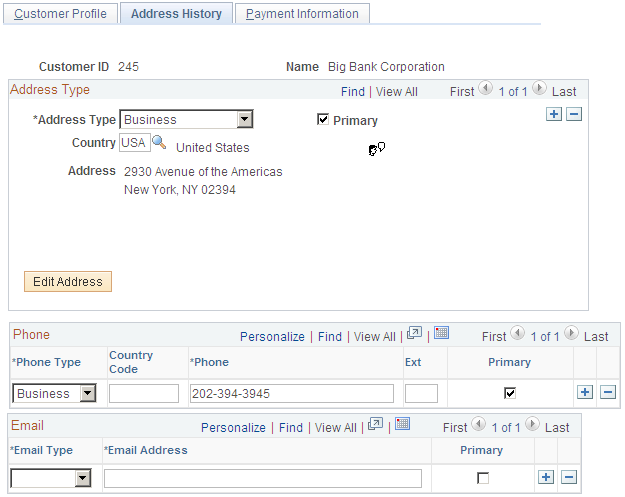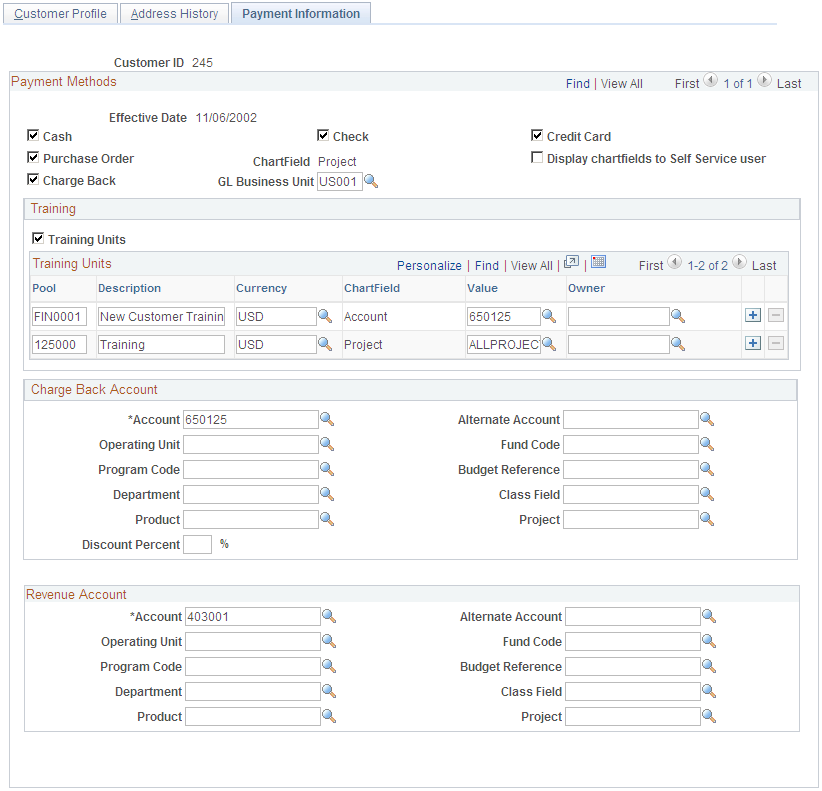Defining Customers
To set up customer profiles, use the Define Customers (LM_CUSTOMER_MAIN) component . You can use the LM_CUSTOMER_MAIN component interface to load data into the tables for this component.
Customers represent organizations with learners who are external to your organization. All customer data is manually entered and maintained. There are no delivered EIPs for synchronizing customer data with other enterprise systems.
|
Page Name |
Definition Name |
Usage |
|---|---|---|
|
LM_CUSTOMER_MAIN_3 |
Define learning-related customer profile information. |
|
|
LM_ORG_ADDR2 |
Define customer address information. |
|
|
Edit Address Page |
EO_ADDR_USA_SEC |
Edit customer address information. |
|
LM_MOP_ADMIN |
Set up default payment methods, training units pools, chargeback accounts, and revenue accounts for a customer organization. |
Before you define customer organizations you must:
Define learning environments.
Define contact method types.
Set up financial ChartField data if your customers can use the charge back payment method for enrollment fees.
Use the Customer Profile page (LM_CUSTOMER_MAIN_3) to define learning-related customer profile information.
Navigation:
This example illustrates the fields and controls on the Customer Profile page.

Field or Control |
Description |
|---|---|
Customer ID |
Enter the customer ID that other enterprise systems (such as financials or customer relationship management systems) use to uniquely identify the customer. |
Learning Environment |
Enter a learning environment with which you associate the customer. Learning environment values are set up on the Learning Environment page. |
Parent Company |
If this customer is associated with a parent company, specify that company here. Note: You must first define the parent company as a separate customer. |
Country |
Enter the country with which this customer is primarily associated. Country codes are synchronized from the HR country code table EIP. |
Stock Symbol |
Enter the customer's stock symbol, if any. |
Industry |
Enter the type of industry with which this customer is associated. Industry values are delivered with your system. |
Business |
Enter a business code. |
Customer Type |
Enter the customer type for this customer. Customer type values are delivered with your system. |
Website URL (website uniform resource locator) |
Enter the customer's website URL, if any. |
Primary Communication
The system displays the customer's primary communication information, as defined on the Address History page.
Use the Customers - Address History page (LM_ORG_ADDR2) to define customer address information.
Navigation:
This example illustrates the fields and controls on the Address History page.

Field or Control |
Description |
|---|---|
Address Type |
Select an address type. Address type values are defined on the Contact Method Type page. |
Primary |
Select to identify an address as primary. Every customer must have one primary address. |
Country |
Enter the country for the address. You must enter a country value if you want to edit the address. |
Address and Edit Address |
Enter a country value if one is not specified, and click the Edit Address link to add or update the address information on the Edit Address page. |
Phone
Field or Control |
Description |
|---|---|
Phone Type |
Select a phone type. Phone type values are defined on the Contact Method Type page. |
Country Code |
Enter the country for the phone type. |
Phone |
Enter the phone number. |
Ext (extension) |
Enter the phone number extension, if any. |
Primary |
Select to identify a phone number as primary. If you have one or more phone numbers for a customer, one must be marked as primary. |
Field or Control |
Description |
|---|---|
Email Type |
Select an email type. Email type values are defined on the Contact Method Type page. |
Email Address |
Enter the email address. |
Primary |
Select to identify an email address as primary. If you have one or more email addresses for a customer, one must be marked as primary. |
Use the Payment Information page (LM_MOP_ADMIN) to set up default payment methods, training units pools, chargeback accounts, and revenue accounts for a customer organization.
Navigation:
This example illustrates the fields and controls on the Payment Information page.

Payment Methods
External learners can only use the payment methods that you define for the customer. The payment methods that are selected by default are inherited from the Learning Environments - Defaults page. You can modify the default selections here.
See Understanding Payment Method Setup.
Field or Control |
Description |
|---|---|
Cash, Check, Credit Card, Purchase Order, and Charge Back |
Select the valid payment methods for the customer organization. |
GL Business Unit (general ledger business unit) |
Select a general ledger business unit. The customer organization inherits ChartField values for chargeback and revenue accounts from the general ledger business unit. Define ChartField values for general ledger business units on the Business Unit Accounts page. This field is required if you select the Purchase Order, Charge Back, or Training Units option. |
Display chartfields to Self Service user |
Select to display ChartFields to self-service learners. If ChartFields appear, learners and managers can change the ChartField values when using the self service pages to enroll. Disable this option if you do not want learners or managers to modify ChartField values. |
Training Units |
Select to enable training units as a valid payment method for the customer organization. |
Pool |
Enter a name for the training unit pool. Names must be unique within a customer organization, but multiple customer organizations can use the same training unit pool name. |
Description |
Enter a description of the training unit pool. |
Currency |
Select the currency for the training unit pool. This currency must match the currency of a class or program fee for a learner to successfully enroll. When training units are used to pay for enrollment, the system converts the training units to a currency value when it writes the payment transaction to the subledger. The currency value is a percentage of the overall cost of the training units divided by the number of training units that is charged for the class fee, program fee, or drop fee. For example, if a customer organization buys 100 training units for 100.00 USD and a learner needs five training units to enroll in a class, the cost of the class in currency value is 5.00 USD. |
ChartField |
Displays the ChartField that is used for training units. Select the ChartField for training units on the Payment Methods page. |
Value |
Select a ChartField value. The ChartField values that you can select are any values with an active status on the Chartfield Values page. |
Owner |
Select an owner for the training unit pool. The owner can be anyone from the customer organization. Owners of training unit pools must approve any enrollment or registration request for a learner that uses the training unit pool when the system requires payment approval to enroll in the class or register in the program. Define approval types for classes on the Classes - Class Details page. Define approval types for programs on the Maintain Programs - Details page. A learner's enrollment or registration in a class or program is not confirmed until the owner gives payment approval. Payment approval is not required if no owner is assigned to the training unit pool or if payment approval is not required to enroll in the class or register in the program. Owners of training unit pools can approve enrollment and registration requests by using the approvals page. |
Charge Back Account
Specify chargeback account information for the customer organization. The ChartFields that the system displays depend on which ChartFields are selected for use on the Chartfield Configuration page. All fields that are in this group box are uneditable until a general ledger business unit is selected in the Payment Methods group box. The system populates the fields with the default ChartField values as soon as you select a general ledger business unit. The ChartField values that you can select for each ChartField are any values with an active status on the Chartfield Values page. Administrators can modify these values during enrollment or registration. Learners and managers can modify these values only if you select the Display chartfields to Self Service user option.
Field or Control |
Description |
|---|---|
Discount |
Enter a discount percentage for the customer organization. The discount applies to all payment methods except training units, because there is a built in discount with this feature. The system applies the discount to all class and program currency prices and drop charges. All learners in the customer organization receive the discount. |
Revenue Account
Specify revenue account information for the customer organization. The ChartFields that the system displays depend on which ChartFields are selected for use on the Chartfield Configuration page. All fields that are in this section are uneditable until a general ledger business unit is selected in the Payment Methods group box. The system populates the fields with the default ChartField values as soon as you select a general ledger business unit. You can modify the default ChartField values. The ChartField values that you can select for each ChartField are any values with an active status on the Chartfield Values page. These values cannot be modified during enrollment or registration.